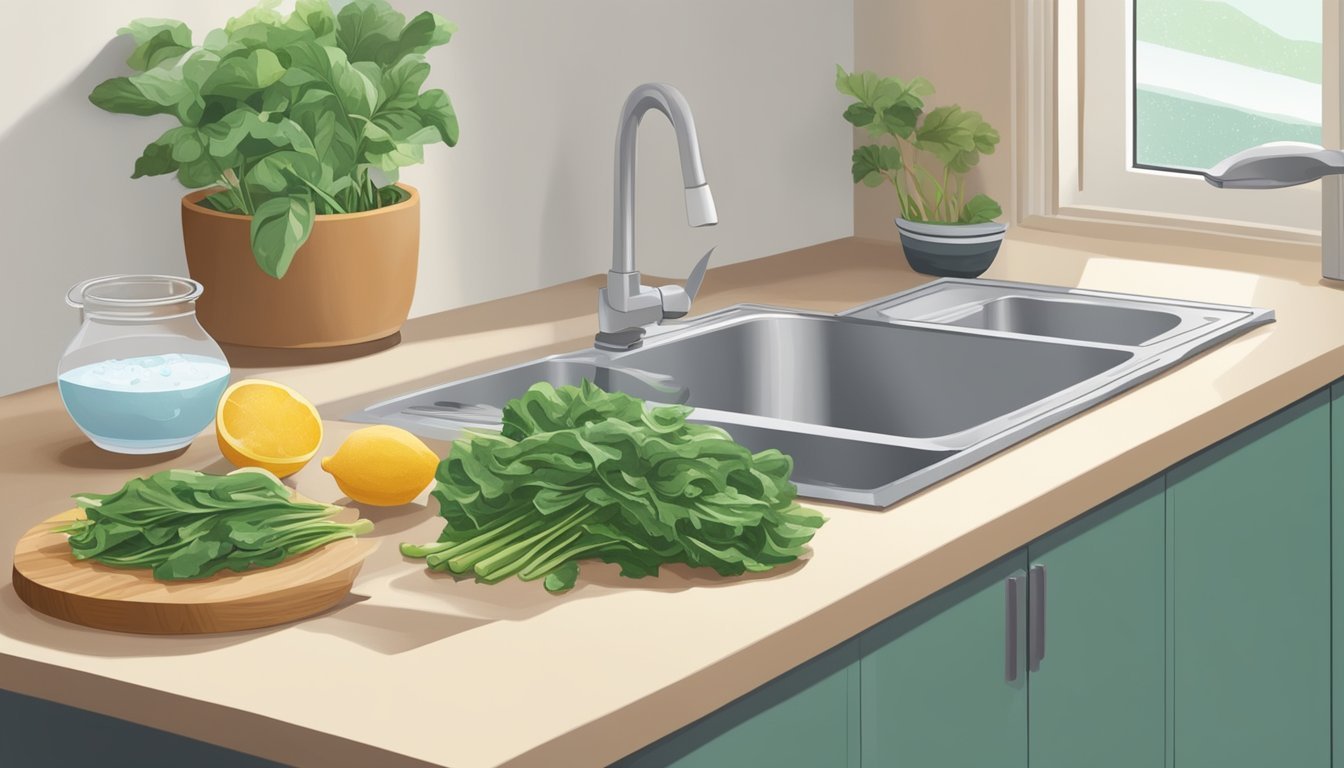Kai lan Substitutes
Best Alternatives for Asian Greens
When a recipe calls for kai lan, also known as Chinese broccoli, it can be challenging to find the exact ingredient in some markets. For those moments, there are several substitutes that offer similar flavors and textures. Broccoli rabe, also known as rapini, is an excellent substitute with its similar crunchy stalks and leafy greens.
Other valuable alternatives include choy sum and broccolini, both of which provide comparable taste profiles and culinary flexibility. For dishes that focus more on the leafy parts, bok choy and collard greens can also serve well. These substitutes not only maintain the integrity of your dish but also add their own unique nutritional benefits.
Kai lan's substitutes are versatile and readily available, making them convenient options to keep your meals diverse and flavorful. Whether stir-frying, steaming, or incorporating them into soups, these alternatives ensure that your culinary experience remains rich and satisfying.
Understanding Kai-Lan
Kai-lan, also known as Chinese broccoli or Chinese kale, is a leafy green vegetable popular in Asian cuisine. Highly nutritious, it provides a rich source of vitamins and minerals essential for health.
Characteristics of Kai-Lan
Kai-lan features thick, crunchy stems, large green leaves, and small flower heads resembling broccoli. The taste is slightly bitter, which mellows when cooked. It is versatile in culinary use, lending itself well to stir-frying, steaming, boiling, and adding to soups.
Common Names:
Chinese Broccoli
Gai Lan
Chinese Kale
Texture:
Thick, crunchy stalks and tender leaves.
Flavor:
Bitter when raw, with a milder, sweeter flavor after cooking.
Nutritional Profile
Kai-lan is a nutrient powerhouse packed with essential vitamins and minerals promoting good health.
Vitamins:
Vitamin A: Supports vision and immune function.
Vitamin C: Enhances immune health and skin integrity.
Minerals:
Calcium: Essential for bone health.
Iron: Important for oxygen transport in the blood.
Other Nutrients: Kai-lan also contains dietary fiber aiding digestion, and antioxidants that can help reduce inflammation.
Nutrient Breakdown per 100g:
Vitamin A: 22% of Daily Value (DV)
Vitamin C: 44% of DV
Calcium: 7% of DV
Including kai-lan in the diet can contribute significantly to meeting daily nutritional needs.
Cooking With Kai-Lan
Kai-lan, also known as Chinese broccoli, is a versatile vegetable enjoyed in many Asian dishes. It can be prepared through various cooking techniques and pairs wonderfully with ingredients like oyster sauce, garlic, and ginger.
Preparation Techniques
Blanching kai-lan is a common method to retain its vibrant green color. Bring water to a boil, immerse the kai-lan for 30 seconds if the stalks are small, and up to a minute for larger stalks. Drain and refresh under cold running water to maintain its crisp texture.
Stir-frying adds a delightful wok hei effect to kai-lan. Heat a wok, add oil, and sizzle sliced garlic until fragrant. Toss in the kai-lan and stir-fry quickly. Adding oyster sauce, soy sauce, and a pinch of sugar enhances the flavor.
Steaming kai-lan preserves most nutrients and offers a tender texture. Place the kai-lan in a steaming basket over boiling water for 4-5 minutes. Serve with a drizzle of oyster sauce and a sprinkle of sesame seeds.
Favored in Asian Cuisine
In Chinese cuisine, kai-lan is often stir-fried with garlic and finished with a splash of oyster sauce. It’s a staple in dim sum and pairs well with proteins like pork or tofu.
Thai cuisine incorporates kai-lan into spicy noodle dishes. It's also commonly found in soups, where it adds a balance of texture and flavor.
Kai-lan can also be enjoyed in Vietnamese cuisine, blanched and served with boiled peanuts and a tangy fish sauce dressing.
Both nutrient-rich and flavorful, kai-lan contributes to a variety of dishes with its slightly bitter taste and crunchy consistency.
Top Kai-Lan Substitutes
Finding the right substitute for kai-lan in your recipes can be straightforward if you know what to look for. Consider options that closely match kai-lan in texture, nutritional value, and ease of substitution.
Similar in Texture
Broccoli rabe (rapini) is an excellent substitute for kai-lan. It has a slightly bitter taste and similar crunchy stalks, large leaves, and small florets, which mimic the texture of kai-lan well.
Broccolini can also be used, offering tender stalks and small, delicate florets.
Yu choy provides a comparable texture with its tender yet firm stalks and leafy tops.
Asparagus offers a unique twist while maintaining a similar crunch to kai-lan.
Similar in Nutritional Value
Kale and collard greens are nutrient-dense options rich in vitamins A, C, and K, similar to kai-lan.
Spinach is versatile and loaded with iron and calcium, making it a great alternative.
Mustard greens bring a spicy flavor and high vitamin content, closely matching the nutritional benefits of kai-lan.
Bok choy is another substitute with a high nutritional profile, including vitamins A and C and calcium.
Ease of Substitution
Regular broccoli is widely available and easy to prepare, making it a convenient substitute. The stalks and florets can be used in a variety of recipes.
Cabbage can be a practical option, particularly in stir-fries and soups, offering mild flavor and simple preparation.
Broccolini is easily substituted in most recipes calling for kai-lan, requiring minimal adjustment in cooking methods.
Yu choy is popular in many Asian markets and can be effortlessly used in recipes that typically call for kai-lan, providing a seamless transition in taste and texture.
Choosing the right substitute depends on the specific recipe and personal preference, but these options can help maintain the intended flavor and nutritional benefits.
Incorporating Substitutes in Diverse Cuisines
Kai lan, also known as Chinese broccoli, can be substituted with various leafy greens and vegetables. Substitutes like broccoli rabe, bok choy, and kale can seamlessly fit into Western and plant-based dishes, adding unique flavors and textures.
Western Cuisine Adaptations
In Western cuisine, kai lan substitutes such as broccoli rabe and kale can be used to enhance salads and soups. Broccoli rabe’s bitterness adds complexity to dishes like Italian pasta and quinoa salads. Kale is versatile in Western cooking, being a superfood rich in vitamins K and C, often combined with Brussels sprouts and cauliflower for nutritious roasted veggies.
For stir-fry dishes, pak choy can be a good option. It has a mild taste that pairs well with garlic and olive oil. Cauliflower can also be used for a low-carb alternative in risottos or pizza crusts. The health benefits of these substitutes include high fiber content and essential minerals, making the dishes not only flavorful but also nutritious.
Substitutes in Vegan and Vegetarian Recipes
In plant-based and vegetarian recipes, bok choy and spinach are excellent kai lan substitutes. Bok choy works well in vegan stir-fry dishes, offering a blend of crunchy texture and mild flavor. This leafy green is also rich in vitamins A and C, promoting health benefits.
Spinach can seamlessly replace kai lan in dishes like lentil soups and veggie wraps. Known for its high iron content, spinach provides significant nutritional value. Nutrient-rich Swiss chard is another substitute, ideal for vegan salads and soups. With its slight sweetness, it complements ingredients like chickpeas and tofu, making a hearty plant-based meal. Using these substitutes ensures the dishes are both delicious and nutritionally beneficial.
Selecting and Storing Substitutes
When choosing substitutes for kai lan, it's crucial to pick fresh alternatives and store them correctly to maintain their quality. Proper selection and storage can enhance the flavors and nutritional benefits of these vegetables.
Optimal Storage Conditions
Freshness and storage temperature are key to preserving the quality of kai lan substitutes.
Store leafy greens like kale, collard greens, and mustard greens in a plastic bag with a slightly damp paper towel. This maintains humidity and keeps the greens fresh for up to a week. Similar methods apply to choy sum and bok choy, which should also be kept in the refrigerator crisper drawer.
Broccolini, asparagus, and brussels sprouts should be stored unwashed and kept cool. To retain their crispness, wrap them loosely in plastic or place them in a breathable container. For extended freshness, store cauliflower and cabbage in perforated plastic bags in the refrigerator.
Selecting Fresh Alternatives
When selecting substitutes, look for vibrant colors and firm textures.
For leafy greens like spinach and swiss chard, choose leaves that are free of yellowing or wilting. Crisp, deep green leaves indicate freshness. Bok choy and choy sum should have firm white stalks and bright green leaves, free from blemishes.
Broccolini should have firm stalks and tight florets with a deep green hue. Asparagus spears should be firm and upright, avoiding any that appear limp or dry. Similarly, choose brussels sprouts that are compact and heavy for their size without any yellowing or loose leaves.
By adhering to these selection and storage tips, you can ensure that the substitutes chosen for kai lan dishes remain fresh and flavorful.






